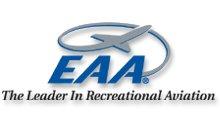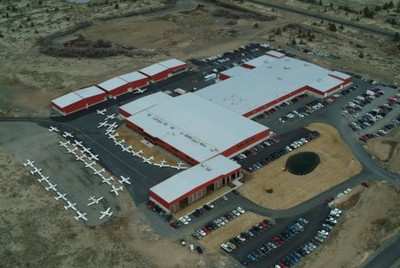Let The Prognostifications Continue!
by ANN Managing Editor Rob Finfrock
The staff of ANN has looked into our crystal balls, and brushed
up on our tarot-reading techniques, to determine our best guesses
to what we consider the 10 Unanswered Questions of 2007, as we face
the new year.

Hopefully, the new year will bring some much-needed
answers...
6) What Does The Future Hold For The Regional Fly-In?
 The year 2007 ended
with some very disturbing news for the organizers of regional
fly-ins... essentially, that the Experimental Aircraft
Association could no longer afford to include those events on its
insurance plan.
The year 2007 ended
with some very disturbing news for the organizers of regional
fly-ins... essentially, that the Experimental Aircraft
Association could no longer afford to include those events on its
insurance plan.
News surfaced December 15 the Southwest Regional Fly-In had
cancelled its 2008 event, and that SWRFI officers and directors
voted to ultimately cease operations. Event organizers told ANN the
decision was due to EAA's decision to "no longer insure regional
events," and that EAA would "cease branding regional fly-ins as EAA
events."
EAA worked quickly to calm the resulting maelstrom of questions
from the organizers and proponents of other regional events, and to
reassure the pilot community other regional events shouldn't feel
threatened. The EAA did acknowledge, however, that some changes
were on the horizon... including, loss of EAA insurance for such
fly-ins.
Before now, EAA arranged for insurance coverage for regional
fly-ins as part of its overall av-insurance plan. Regional
organizers would then reimburse EAA for their portion of insurance
costs -- meaning, in essence, fly-ins benefited from paying the
EAA's rates. A recent court case, though -- stemming from a July 7,
1999 fatal takeoff accident at the Northwest Regional Fly-In in
Arlington, WA -- hit the EAA hard, when a jury slammed the
organization with the bulk of a $10.5 million judgment in that
accident.
As ANN reported, that
judgment came despite significant evidence, including eyewitness
accounts and the NTSB's Probable Cause report, the accident was the
result of a departure stall, and was in no way due to any actions
on the part of EAA... fly-in organizers... city or county
personnel... in essence, no one but the pilot of the RV-6A, who,
sadly, was lost in the crash.

"The damage award affected the evaluation of EAA's coverage in
the insurance market and created a situation that, if not
addressed, would lead to very significant and unsustainable
increases in the cost of EAA's insurance coverage at the levels
required for all of its programs," EAA said in a December posting
on its website.
Unfair as it is, that judgment also explains why EAA is no
longer particularly eager to explicitly label regional events as
"EAA" fly-ins.
For its part, EAA says it will continue to support such events
through more indirect means -- such as promoting the events in EAA
literature and newsletters, and sponsoring workshops and forums.
The organization will also offer limited help for events to secure
outside insurance, by steering organizers to outside insurance
providers.
"Fortunately, there are brokers and underwriters willing and
capable of serving the regional fly-ins as independent events at
what we anticipate will be affordable and sustainable rates," the
group adds. "EAA will introduce the fly-in organizers to insurers
that can independently provide quotes for this coverage."
Still, those rates are almost guaranteed to be significantly
higher than the previous EAA-sanctioned premiums... a difference
that will hit the already cash-strapped coffers of some smaller
regional events VERY hard, and may well mean the demise
of those fly-ins.
7) Will Lawsuits Never Cease?
 It's
no coincidence this comes immediately after ANN's
concerns about regional fly-ins, because those worried about
their local regional fly-in surviving the next few years have
lawyers to "thank," pure and simple, for their concerns... a simple
fact that may prompt those parties, if nothing else, to brush up on
their Shakespeare.
It's
no coincidence this comes immediately after ANN's
concerns about regional fly-ins, because those worried about
their local regional fly-in surviving the next few years have
lawyers to "thank," pure and simple, for their concerns... a simple
fact that may prompt those parties, if nothing else, to brush up on
their Shakespeare.
Tort reform was supposed to provide the aviation world with a
sigh of relief -- and while in some ways it HAS made a difference,
we're still waiting for the real benefits that occur when attorneys
stay out of the engine compartment, the cockpit, the cabin, the
control tower... the list goes on.
Sadly, a predilection for all-too-eager ambulance-chasing may
not be the worst threat lawyers pose to the very existence of
general aviation. In his recent "Heartbreakers" missive, Jim
said it best when he opined, "What's almost as disturbing as the
suits themselves, is the "PR Dance" that precedes them... where
lawyers seem able to say anything they want in order to garner
sympathy and plant suggestions in the minds of the jury pool."
In other words, lawyers have realized the first shots in winning
their cases against pilots, planemakers, or aviation organizations
come not before the judge, but in the court of public opinion. As
you well know, the general public is often frighteningly
ill-informed about issues concerning aviation... and, they are
ALWAYS willing to hear how an unfamiliar group or activity may put
them at risk, even if that risk is nigh-infinitesimal. Or blatantly
false.
As a slew of unjustified and uninformed lawsuits continue
to be brought against respected planemakers like Cirrus and Cessna,
and entities like EAA, lawyers will continue to stymie the
sustained growth of GA. That's not open to debate. Where the
question lies, is to what extent the flawed litigation system
at work in the United States will damage the aviation community
even further in 2008.
One final note... as pilots, we must do all we can to make
sure these clowns suffer a decrease in their av-related
business. How? By continuing to fly smart, and avoiding the
very kinds of situations that led to many of the accidents
that prompted such lawsuits. Consider that a personal request...
we'll also enjoy the added benefit of living to fly another
day.
8) Will Cessna Make Cirrus Regret NOT Buying Columbia?
It's a scenario that should give the marketing people at such
companies as Piper, Diamond, and Cirrus fits: a highly-capable,
VERY quick, and much-beloved airframe... that until recently was
little-more than a niche player in the marketplace due to
production limitations and, arguably, mismanagement on the
part of its former overseas owners... now emboldened with the
advertising, sales, and production might of that 800-lb gorilla of
general aviation, Cessna.

Of course, hanging a Cessna sign outside the former
Columbia Aircraft Manufacturing plant in Bend, OR won't magically
bring production rates up to the levels of the venerable Skyhawk
and Skylane lines -- and it's highly unlikely we'll ever see
newly-renamed Cessna 350s and Cessna 400s flying off the ramp, as
it were, at the rates Cirrus manages with its highly-popular SR
series.
Make no mistake, though, Cessna intends to take a big chunk out
of the latter's sales numbers with its acquisition of CAM. It
likely will, too, especially as customers attracted
to Columbia planes -- but who may have stayed away as the
turmoil of that former company became evident -- slowly return
to the Bend fold... nevermind the occasional 172 or 182 owner
who will opt for a major upgrade to their aerial chariot of
choice.

Cirrus, for one, had its chance. The company expressed
interest early in bidding for Columbia, but pulled out of the
running near the end when it became clear the cost of adapting
the Columbia airframe with the Cirrus-signature ballistic parachute
system would not be easy -- and prohibitively expensive, if in fact
possible at all. The Duluth, MN planemaker also said the cost of
ramped up high-rate production in Bend would bring significant
costs, as would continued issues with Columbia's Evade deicing
system.
Good points, all... and Cirrus officials would be the first
to admit Textron-owned Cessna has far greater resources available
to devote to solving Columbia's woes than they do. As a
result, however, Cirrus essentially handed Cessna a stake in the
marketplace for high-performance, technologically-advanced,
composite-bodied aircraft.

One must wonder if the price of that decision will ultimately be
higher, than if Cirrus would have purchased Columbia outright.
9) Will The LSA Market Show Some REAL Growth In 2008?
Brass tacks time, folks: the training revolution light sport was
to represent, when the FAA created the sport pilot category in
2005, hasn't happened yet. Flight schools offering LSA training are
still few and far between... and some which offered the option
early have had mixed results.

For example... the flight school I flew from last year, while I
lived in the DFW area, is now awaiting its third LSA, a CZAW
SportCruiser -- after seeing its SportStar and Thorpedo
both succumb to accidents, one of them serious. The
school near where I live now, on the west side of Albuquerque,
NM is still without an LSA offering, after its Flight
Design CT landed hard last March.
Nor have scores of "affordable" (cough) aircraft brought
appreciably greater numbers of new pilots into the fold. Let's face
it... if you can't afford a $200,000 aircraft, chances are likely
you won't be able to afford a $130,000 one, either. To find a
new S-LSA below $100,000, you either need to search for a
stripped model... or, resign yourself to flying an aircraft with
its roots nearer to ultralights than conventional aircraft.

As for renting an LSA... if you can find one (again, no easy
task) there is a cost advantage, though it's not a very significant
one. My quick, informal survey of online prices indicate LSA
rental costs throughout the country still average around
$80-$100 per hour wet... certainly cheaper than what you'll spend
to train in a newish Skyhawk, but arguably not enough of a
difference that one might not opt to instead spend
the extra $30 per hour for the larger, (again, arguably) more
desireable aircraft, so long as the FBO is picking up fuel costs.
As fuel prices continue to climb, though, that may well change.
If sport pilot isn't all it was played up to be at this point,
at least it's not for a lack of choices. Pilots and flight schools
interested in purchasing a new light-sport aircraft have a plethora
of choices to select from. In addition to numerous homebuilt
options for private customers, there are no fewer than
65 ASTM-approved S-LSA now available to potential buyers,
with at least two more to be announced next week at the
Sport Aviation Expo in Sebring, FL. (In the time it took me
to write this, ANN learned of one new entry, the RANS S-19LS.)
And, of course, the Cessna SkyCatcher is on the horizon.

Choice is good, don't get me wrong... but 65 planes?
That number is absolutely ridiculous, especially as light sport
continues to be a relative novelty in general aviation.
There is no way the market will be able to sustain that many
competitors.
Which leaves... well, what, exactly? What is the magic solution
that will bring LSA into the mainstream? Is it the SkyCatcher,
which should be deployed en masse throughout Cessna Pilot Centers
within the next three years?
That may help... but in the end, nothing short of a drastic
price reduction across the board will truly invigorate LSA.
Don't hold your breath on that one, folks.
10) When Will NASA Admit It Can't Wrap Up Shuttle Missions By
2010?
Talk about looking at the glass as half-full. This week, NASA
announced its plan to send the shuttle Atlantis on a repair mission
to the Hubble Space Telescope in August of this year, one of six
planned shuttle flights for 2008.

Meanwhile, Atlantis sits on the pad, over one month after NASA
originally planned to send the orbiter on yet another construction
mission to the International Space Station. A troublesome fuel
sensor glitch -- a problem that's popped up on Atlantis before --
is to blame, and NASA engineers are working furiously to implement
a temporary fix that would allow the orbiter to finally blast off
sometime after January 24.
Given that NASA was only able to send three orbiters into
space in 2007 -- it would have been four, had Atlantis launched on
time -- many find it extremely unlikely NASA will come close to six
launches in 2008. Based on the agency's past performance in the
two-and-a-half years since Discovery lifted off, restarting the
shuttle program after the loss of Columbia, the agency would be
fortunate to launch four missions this year.
There are 11 missions remaining, including the shuttle on the
pad now and the Hubble repair flight, to be completed ahead of the
White House-mandated September 30, 2010 retirement of the shuttle
fleet. Do the math... that means the agency will need to hit at
least a four-launch-per-year total over this year and the next, and
three missions in the first nine months of 2010.
NASA has accomplished such ambitious launch schedules before; in
fact, the most active year, 1985, saw nine missions launched. More
recently, the agency launched eight missions in 1997. NASA had
a four-orbiter fleet to work with in 1985; in 1997, it only had
three, same as now, as Endeavour underwent upgrades that year.
 So, you could argue --
theoretically at least -- NASA should be able to hit its goal,
maybe even with some breathing room. This assumes an absolute
best-case scenario, however... something NASA appears to be banking
heavily on, though "best-case" has never been a reliable assumption
in space travel.
So, you could argue --
theoretically at least -- NASA should be able to hit its goal,
maybe even with some breathing room. This assumes an absolute
best-case scenario, however... something NASA appears to be banking
heavily on, though "best-case" has never been a reliable assumption
in space travel.
Will NASA be able to send 11 more shuttles spaceward in the next
33 months? Frankly, I doubt it. There are too many variables... too
many things that can go wrong, on the pad and in the sky, with an
aged fleet of obsolete spacecraft that were built to cost.
I'm not alone in fretting over the pressure NASA has had placed
on it... nor am I alone in my concern about the agency's
performance when it feels such pressure.
John Logsdon, chairman of the Space Policy Institute at The
George Washington University and a member of the panel that
investigated the 2003 Columbia disaster, recently stated another
shuttle failure would not only result in the loss of a crew, and
the permanent halting of the program... it would have lasting,
damning consequences for manned spaceflight in the United States
for at least the next several years.
"Every time we launch a shuttle, we risk the future of the human
space flight program," he said. "The sooner we stop flying this
risky vehicle, the better it is for the program."
Conversely, the less pressure NASA feels to launch as many
shuttles as possible, in the least amount of time... the less
chance there is of a rushed schedule leading to the kind of safety
oversights that doomed Challenger, and Columbia.
NASA needs to face reality, and tell the White House it needs
more time to do the job right, and as safely as possible, with the
equipment at hand. That's not the scenario in place at the
moment.
The President can explain to the Europeans, Russians and
Japanese why the ISS will remain permanently unfinished if he
doesn't grant that request.
 Aero-News: Quote of the Day (04.17.24)
Aero-News: Quote of the Day (04.17.24) ANN's Daily Aero-Linx (04.17.24)
ANN's Daily Aero-Linx (04.17.24) Airborne-Flight Training 04.17.24: Feds Need Controllers, Spirit Delay, Redbird
Airborne-Flight Training 04.17.24: Feds Need Controllers, Spirit Delay, Redbird Airborne 04.16.24: RV Update, Affordable Flying Expo, Diamond Lil
Airborne 04.16.24: RV Update, Affordable Flying Expo, Diamond Lil Airborne 04.11.24: SnF24!, King's 50th, Top Rudder, Aileronics
Airborne 04.11.24: SnF24!, King's 50th, Top Rudder, Aileronics














